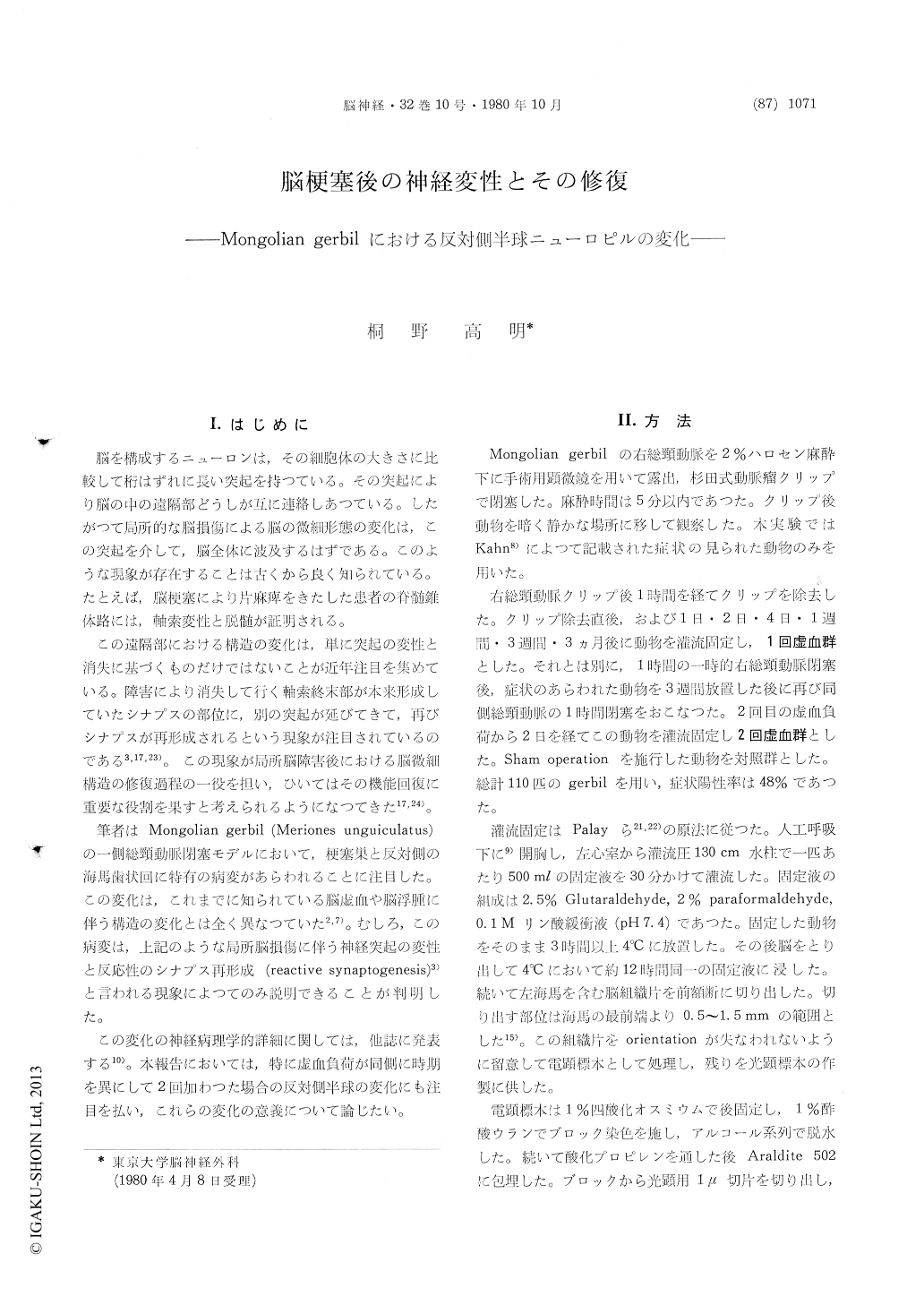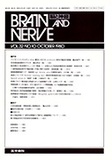Japanese
English
- 有料閲覧
- Abstract 文献概要
- 1ページ目 Look Inside
I.はじめに
脳を構成するニューロンは,その細胞体の大きさに比較して桁はずれに長い突起を持つている。その突起により脳の中の遠隔部どうしが互に連絡しあつている。したがつて局所的な脳損傷による脳の微細形態の変化は,この突起を介して,脳全体に波及するはずである。このような現象が存在することは古くから良く知られている。たとえば,脳梗塞により片麻痺をきたした患者の脊髄錐体路には,軸索変性と脱髄が証明される。
この遠隔部における構造の変化は,単に突起の変性と消失に基づくものだけではないことが近年注目を集めている。障害により消失して行く軸索終末部が本来形成していたシナプスの部位に,別の突起が延びてきて,可びシナプスが再形成されるという現象が注目されているのである3,17,23)。この現象が局所脳障害後における脳微細構造の修復過程の一役を担い,ひいてはその機能回復に重要な役割を果すと考えられるようになつてきた17,24)。
Definite morphological changes were noted in the contralateral hemisphere of the brain of Mongolian gerbils (Meriones unguiculatus), which were sub-jected to unilateral carotid occlusion for 1 hour. The alterations were evident especially in the dentate gyrus of the contralateral hippocampal formation. It was remarkable that the findings were transient. They were most demonstrable 2 to 4 days after the carotid occlusion, but disap-peared for the most part by 7 days. In another group of gerbils, which were kept in cages for 3 weeks after ischemic insult and subjected to the 2nd 1-hour occlusion on the same side, the findings were quite different. Although the animals de-veloped definite ischemic symptoms following the 2nd occlusion, changes in the opposite hemisphere were minimal.
The design of the experiment was as follows. Animals which developed several symptoms during 1 hour of occlusion were used. Immediately after clip removal, or 1,2,4,7,21 or 90 days afterward, they were fixed by transcardiac perfusion. Another group of gerbils, which were subjected to repetitive ischemic insult two times, were fixed by perfusion 2 days after the 2nd occlusion. Small blocks of tissue were obtained from the contralateral (left)hippocampus of the fixed brains. Care was taken not to lose orientation. These specimens were processed for electron microscopy. The rest of the brain served for light microscopic preparations. One hundred and ten gerbils including controls were used in this experiment.
The changes in the contralateral dentate gyrus appeared different from any previous descriptions which had been made concerning cerebral ischemia and ischemic edema. In the opposite dentate gyrus, they were located in the inner 1/3 (near the granule cell layer) of the dentate molecular layer. Electron microscopy revealed that they corresponded to swollen presynaptic sites which were in the process of terminal degeneration. The changes were transi-ent. The neuropil of the dentate molecular layer was rapidly repaired, so that it was almost normal by light microscopy after 7 days. The peculiar ana-tomical feature of the dentate gyrus contributes to the genesis of the changes. The commissural fibers from the right hemisphere, a part of which has been infarcted, form synapses in the inner 1/3 of the dentate molecular layer. The changes in the inner 1/3 of the layer of the opposite side were supposed to be caused by terminal degeneration of the commissural system and subsequent repair mechanisms.
In focal brain damage, for example, focal cerebral infarction, the morphological changes are not "focal"on the level of fine structure. The effect of local damage propagates through exceedingly long processes of the neuron. Thereafter, synapses are thought to be reestablished by the sprouting of local undamaged axons. By these repair mechan-isms, the brain reforms itself in response to local damage. After a certain period of time, the brain alter its previous structure. It is supposedly by these mechanisms, that the morphological behavior of the contralateral dentate gyrus was very different in cases of repetitive ischemia. These experimental results might be of clinical significance concerning recurrent cerebrovascular attacks in man.

Copyright © 1980, Igaku-Shoin Ltd. All rights reserved.


